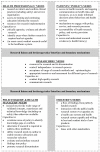Who needs what from a national health research system: lessons from reforms to the English Department of Health's R&D system
- PMID: 20465789
- PMCID: PMC2881918
- DOI: 10.1186/1478-4505-8-11
Who needs what from a national health research system: lessons from reforms to the English Department of Health's R&D system
Abstract
Health research systems consist of diverse groups who have some role in health research, but the boundaries around such a system are not clear-cut. To explore what various stakeholders need we reviewed the literature including that on the history of English health R&D reforms, and we also applied some relevant conceptual frameworks.We first describe the needs and capabilities of the main groups of stakeholders in health research systems, and explain key features of policymaking systems within which these stakeholders operate in the UK. The five groups are policymakers (and health care managers), health professionals, patients and the general public, industry, and researchers. As individuals and as organisations they have a range of needs from the health research system, but should also develop specific capabilities in order to contribute effectively to the system and benefit from it.Second, we discuss key phases of reform in the development of the English health research system over four decades - especially that of the English Department of Health's R&D system - and identify how far legitimate demands of key stakeholder interests were addressed.Third, in drawing lessons we highlight points emerging from contemporary reports, but also attempt to identify issues through application of relevant conceptual frameworks. The main lessons are: the importance of comprehensively addressing the diverse needs of various interacting institutions and stakeholders; the desirability of developing facilitating mechanisms at interfaces between the health research system and its various stakeholders; and the importance of additional money in being able to expand the scope of the health research system whilst maintaining support for basic science.We conclude that the latest health R&D strategy in England builds on recent progress and tackles acknowledged weaknesses. The strategy goes a considerable way to identifying and more effectively meeting the needs of key groups such as medical academics, patients and industry, and has been remarkably successful in increasing the funding for health research. There are still areas that might benefit from further recognition and resourcing, but the lessons identified, and progress made by the reforms are relevant for the design and coordination of national health research systems beyond England.
Figures
References
-
- Polyani M. The Republic of Science: Its political and economic theory. Minerva. 1962;1(54):73.
-
- Gibbons M, Limoges C, Nowotny H, Schwartzman S, Scott P, Trow M. The New Production of Knowledge. London: Sage; 1994.
-
- Irwin A. Constructing the scientific citizen: science and democracy in the biosciences. Public Understanding of Science. 2001;10:1–18. doi: 10.1088/0963-6625/10/1/301. - DOI
LinkOut - more resources
Full Text Sources
Research Materials


